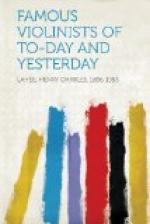Lafont was born at Paris, December 7, 1781, and received his first lessons from his mother, who afterward placed him under her brother, Berthaume. Under his care he made a successful concert tour through Germany and other countries as early as 1792, after which he returned to Paris and settled down to study under Rudolf Kreutzer.
For a time his studies were interrupted by an attempt to become a singer, and he appeared at the Theatre Feydeau, which had then been opened by Viotti. This diversion being soon at an end, he returned to the violin, but on the outbreak of the revolution in France he left the country and travelled throughout Europe, being absent from Paris, with the exception of a short visit in 1805, until 1815.
During his travels he was made chamber virtuoso to the Czar Alexander, and on his return to France he became first violinist of the royal chamber musicians of Louis XVIII., and musical accompanist to the Duchesse de Berry.
Lafont’s career came to a sudden end by the overturning of a carriage while on a concert tour in the south of France in 1839.
He was one of the numerous violinists who challenged Paganini to an artistic duel, in which he got the worst of it, though his admirers accounted for his defeat by the fact that the contest took place at La Scala, in Milan, where the sympathy of the audience was in favour of the Italian virtuoso.
Lafont was a prolific composer, but few of his works have survived. He was also the owner of a magnificent Guarnerius violin, which is now said to be the property of Adolf Brodsky.
As a composer Spohr probably influenced the modern style of violin playing even more than as a player, for he lifted the concerto to the dignity of a work of art, whereas it had formerly been simply a show piece, though not always without merit. He set a great example of purity of style and legitimate treatment of the instrument, and is considered to have had a more beneficial effect on violin playing than Paganini, who was born in the same year, 1784.
Louis Spohr was the son of a physician, who, two years after Louis was born at Brunswick, took up his residence at Seesen, where the childhood of the future virtuoso was passed. Both father and mother were musical, the former playing the flute, while the latter was a pianist and singer. It is said that young Spohr showed his talents remarkably early, and was able to sing duets with his mother when only four years of age. At five he began to learn the violin and at six he could take part in Kalkbrenner’s trios. He also began to compose music, and under his father’s methodical guidance acquired the habit of finishing everything that he began to write, without erasure or alteration. His instruction in the art of composition was confined to the mere rudiments, and he acquired the art chiefly by studying the scores of the great composers.
Spohr’s first public appearance was at a school concert, and such was his success that he was asked to repeat the performance at a concert given by the duke’s band. More study ensued, and then, at the age of fourteen, he undertook to make his first artistic tour, and set out for Hamburg, carrying with him some letters of introduction.




